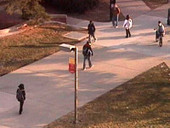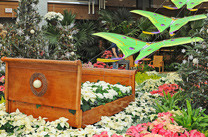Recipe for success
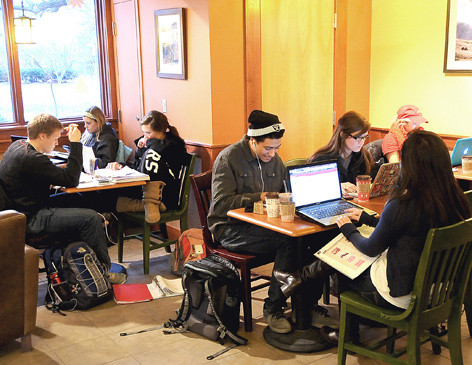
A Wi-Fi zone, a dose of caffeine and a few comrades: the perfect recipe for some serious studying. In preparation for final exams, this group of students hit it hard at The Hub earlier this week. Photo by Bob Elbert.
Five questions for John Hoffman
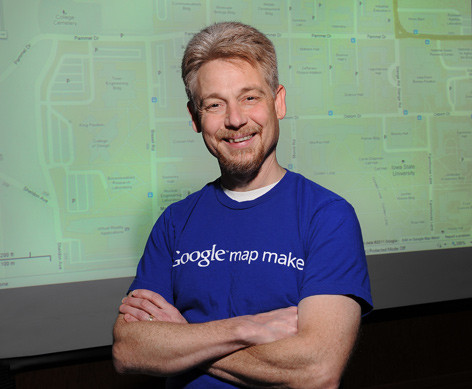
Map maker and cam master John Hoffman. Photo by Bob Elbert.
He puts Iowa State on the map, literally, and recently got a prestigious nod from Google for his map-making contributions. He's also the man behind several webcams peeking in on campus activities. Facilities planning and management's John Hoffman helps people get around -- and look around -- the university.
Google recently named you one of the top map makers in the country. What did you do to receive this honor?
Using the Google Map Maker tool, I've been adding buildings, streets, parking lots and sidewalks to the ISU campus as it appears on Google maps. I've posted about 1,700 objects on the map thus far.
The basics
- Name: John Hoffman
- Position: Web technologist, facilities planning and management
- Years at ISU: 23
- Education: Bachelor's in computer engineering, Iowa State, 1982
Doesn't Google maps already have these features on the satellite view?
Yes, most of them, but I am able to put some rich data behind the map feature. All of the buildings I have drawn contain a link to the web page for that building. And satellite views can be several years old. For example, our Biorenewables Research Laboratory and the Lloyd Center in the Vet Med complex were missing until I drew them in. Satellite views also may be distorted because satellites aren't always directly overhead or because trees or roof lines overhang buildings' actual ground-level footprints. I redraw the buildings to correct for that.
So, can I get on Google and map my neighborhood?
You can. Google's theory is that local people know local geography. Anyone can use Google Map Maker to offer edits. But there's an extensive review process to get your changes through the system. I've done enough edits to build up credibility with Google reviewers, and my edits usually get a smoother path through the review process.
Iowa State already has an online map. Why bother with Google maps?
Our online map works great on full-sized computers, but not so well on mobile devices. Google is scalable to these smaller devices and, more importantly, it's very popular. People are going to Google when they think of maps, and Google continues to add features to its map engine to make it better. The next version of ISU's online map likely will use Google's map, overlaid with the data that we currently have on such things as accessibility, bike routes, recycling areas and emergency phones.
You also manage campus webcams. Do you have a sense of who's watching?
Our construction cameras are primarily for the benefit of project and construction managers, who use them to monitor several projects from their offices or smart phones. These construction sites often are of great interest to the public, though. The camera we had on the new football scoreboard was so popular that I had to set up a dedicated video server for that one camera.
Our cams atop Memorial Union and Parks Library, allow the general public to peek in on campus life and can be controlled by anyone watching. (Everyone gets a turn at controlling the camera for two minutes at a time.) These are very popular with alumni and parents alike. I've had email conversations with people from all over who enjoy using those cameras to connect with their children or memories.
It's time to make winter break preparations
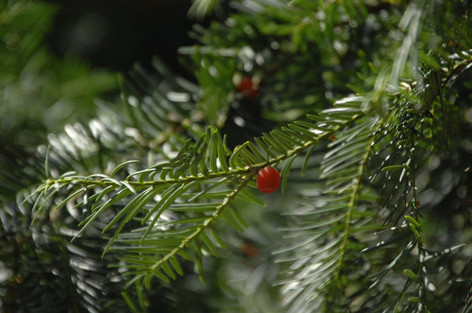
Seasonal foliage near Lagomarcino Hall. Photo by Barb McBreen.
Open or closed?
Winter break is fast approaching, which means staff in departments across campus need to decide whether they will be open, closed or something in-between Dec. 23 through Jan. 2.
In September, university officials approved a partial shutdown of campus during winter break. This period includes three university holidays (Dec. 23, 26 and Jan. 2), four weekend days and four work days (Dec. 27-30). Employees who choose not to work Dec. 27-30 may use vacation time or take unpaid leave. The partial shutdown is optional; the university is not requiring departments to close.
Building supervisors should contact Bob Currie in facilities planning and management (FPM) by Dec. 22 to indicate whether a building will be closed or to request a temperature setback.
If your department or building will be shut down during break, remember these tips to keep your office safe and energy-efficient.
Don't just turn off the lights
- Shut down all computers, printers and other accessories. Leave your office computer on if you need remote access from home, but power off the monitor, printer, speakers, etc. A computer's sleep mode uses less energy than full power, but information technology services guidelines recommend shutting down computers completely to protect data. A machine may be left on during break if it's providing access to a critical application. If possible, plug computers and printers into a power strip and then shut off the power strip before you leave.
- Turn off and unplug copiers.
- Shut off and unplug small appliances, like coffeepots.
- Unplug all chargers for cell phones, MP3 players and similar devices.
- Check faucets in bathrooms and break rooms to make sure they are completely turned off and not dripping. If you notice a dripping faucet, contact the FPM Service Center, 4-5100.
- If you can manually adjust the thermostat in your office, turn it down to 65 degrees.
- Close fume hood sashes completely or open them only minimally.
- Shut down unnecessary climate-controlled plant growth chambers.
- Shut down cooling water systems to eliminate potential flooding issues.
- Remember to turn off your office lights and as much public lighting (hallways, bathrooms, conference rooms) as possible before you leave.
- Check windows to make sure they're shut tight.
Communication is key
If your department is closing over break, discuss how to handle incoming phone calls. One option is to direct all departmental calls to one voicemail box to be checked periodically by designated employees during the break. Employees also should change their personal voicemail and email messages. Consider stating the dates you will be absent, and if you'll be checking your voicemail or email messages. If necessary, include an off-campus number where you can be reached. Also consider putting your department's holiday hours on your unit's web page.
Wear your boots
Facilities planning and management crews will work reduced hours during the partial shutdown. From Dec. 23 to Jan. 3, snow removal will be limited, which means parking lots and building entrances may not be plowed by 8 a.m. FPM staff also will not plow lots or sweep sidewalks for less than 2 inches of snow outside of weekday business hours (Monday through Friday, 7 a.m. to 4 p.m.).
Break schedules
Be prepared
Following is a list of closures for various campus facilities during winter break. When in doubt, call ahead.
Athletics ticket office, Olson Building
Closed: Dec. 23-27, Jan. 2
Holiday hours: Dec. 28, 1-5 p.m.; Dec. 29-30, noon-3 p.m.
Ticket office at Hilton Coliseum will be open one hour prior to basketball games on Dec. 29, 30 and 31
Brunnier Art Museum (295 Scheman)
Closed: Dec. 23-Jan. 9
Christian Petersen Art Museum (1017 Morrill)
Closed: Dec. 16-Jan. 8
Farm House Museum (central campus)
Closed: Dec. 17-Jan. 8
Hotel Memorial Union
Closed: 5 p.m. Dec. 23-8 a.m. Dec. 26
ISU Dining
Winter break hours
ISU Postal and Parcel
Operating normal hours with reduced staff; regular service will continue to accessible buildings
Lied Center/Beyer Hall
Winter break hours (PDF)
Maintenance Shop, Memorial Union
Closed: Dec. 16-Jan. 8
Memorial Union
Closed: Dec. 23-25 (free parking in ramp when gate is up)
Reiman Gardens
Closed: Dec. 25 and Jan. 1
Extended hours: Free admission 4:30-8 p.m. Thursday nights in December (Butterfly House is closed evenings)
University Book Store
Closed: Dec. 23-26; Dec. 31-Jan. 2
Holiday hours over semester break: Mon.-Sat., 7:45 a.m.-5 p.m.; noon-4 p.m. Sunday
University Library (all sites)
Closed: Dec. 23-Jan. 2; e-Library remains open
More than 1,600 completed degrees this fall
An anticipated 1,650 students completing an Iowa State University degree this semester will be honored during a single commencement ceremony Saturday, Dec. 17, in Hilton Coliseum. And about 10 percent -- approximately 85 -- of those students who finished their degrees during summer session elected to join them at the 2 p.m. ceremony. Tickets are not required.
As of Dec. 12, 1,250 students are expected to complete bachelor's degrees this semester. An estimated 262 master's candidates and 108 doctoral candidates also will graduate this weekend.
The commencement ceremony will be Gregory Geoffroy's final one as president of the university.
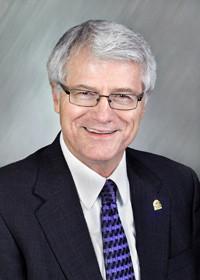
Honorary degree recipient Ben Allen. Contributed photo.
Honorary degree
Former Iowa State faculty member, Business dean and provost Ben Allen will receive a Doctor of Humane Letters from the university for excellence in educational leadership and for scholarly contributions to the field of transportation and logistics. Since 2006, Allen has served as president of the University of Northern Iowa, Cedar Falls. He will give the commencement address.
Allen joined the Iowa State faculty in 1979 and became chair of the department of transportation and logistics in 1984. In 1988, he and a colleague from the University of Iowa established the Midwest Transportation Center at ISU; Allen directed that center for two years. He was appointed interim dean of the College of Business in 1994 and dean in 1995, where he served until 2001. He was named interim vice president for external affairs in 2001-02 and served as vice president for academic affairs and provost from 2002 to 2006.
In addition to his exceptional career in academic administration, Allen is a nationally recognized researcher and educator in transportation and logistics, particularly in the areas of regulator reform, deregulation and public transportation policy. In 1988, he was named Iowa State's first Distinguished Professor in Business.
College events, reception
Iowa State's colleges also will honor their graduating students during separate receptions or convocations Dec. 16 and 17. A complete list of graduation events is available on the registrar's website. All graduates and their families are invited to a free reception at the alumni center, 420 Beach Ave., following the ceremony and continuing for about two hours.
VanDerZanden named CELT director
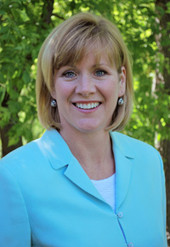
Ann Marie VanDerZanden. Photo by Cindy Haynes.
Horticulture professor Ann Marie VanDerZanden has been named director of the Center for Excellence in Learning and Teaching (CELT). VanDerZanden, associate director of CELT and its interim director since Aug. 1, also will serve as co-director of the learning communities program with Doug Gruenewald, program manager in student affairs.
"Dr. VanDerZanden's strong background and personal contributions to enhanced student learning -- coupled with her enthusiasm and passion for leading and nurturing innovation in teaching and learning -- will enable her to provide creative and effective leadership to both the Center for Excellence in Learning and Teaching and learning communities," said David Holger, associate provost. "I am delighted that she has accepted this important leadership position, and look forward to collaborating with her to enhance the learning experiences and success of our students."
VanDerZanden came to Iowa State in 2003 after serving six years at Oregon State University. She earned horticulture degrees from Washington State University (B.S., 1988; Ph.D., 1994) and Cornell University (M.S., 1990), and also held positions at Illinois State University (assistant professor) and the University of Illinois (Extension horticulture specialist).
VanDerZanden replaces Steve Mickelson, who left the post to become chair of the agricultural and biosystems engineering department. She will assume her duties on Jan. 3.
School of Education clears final hurdle
A national search for the first director of Iowa State's School of Education will begin immediately, following final approval of the school Dec. 8 by the state Board of Regents.
Effective July 1, 2012, the school will have its home in the College of Human Sciences and combine two departments (curriculum and instruction, and educational leadership and policy studies) and the teacher education program. In addition to a director, the leadership team will include an assistant director and coordinators of its three divisions -- educator preparation studies, educator foundation core and educator leadership studies.
Following a year of planning, faculty and staff in the two affected departments and the teacher education office approved the proposed school in a 53-9 advisory vote in May. Executive vice president and provost Elizabeth Hoffman recommended the proposal in June to the Faculty Senate, which approved the proposed school in October.
2012-13 tuition and fees
Under new 2012-13 rates approved by the board, tuition will increase $240 (3.75 percent) for resident undergraduates and $480 (2.63 percent) for out-of-state undergraduates. Graduate tuition will increase $280 (3.7 percent) and $504 (2.6 percent) for resident and nonresident students, respectively. Iowa State will hold mandatory student fees at this year's rates for all students.
Regent Ruth Harkin cast the sole dissenting vote (regent Craig Lang was absent).
"Most Iowans' incomes have not kept up with inflation," she noted. "Next year, I hope we can work harder to find a better solution."
Regent Robert Downer said part of the solution could be to better demonstrate to legislators this winter the effect of student debt loads (caused in part by high tuition) on the Iowa workforce. Downer said incomes and the cost of living are lower in Iowa, and students' debt repayment obligations impact their decisions to stay in Iowa or work elsewhere. By reducing state appropriations, legislators are "jeopardizing the efforts of young people to secure jobs in the Iowa economy," he said.
Differential tuition
The board approved differential tuition next year for four student groups: juniors and seniors in agricultural systems technology and industrial technology (both in the ag and biosystems engineering department), and undergraduate and graduate architecture students. The AST and ITec upper division students will pay an additional $584, the second of a proposed three-year incremental increase to lower student-to-faculty ratios and provide excellent instruction and cutting-edge lab experiences. All architecture students will pay $400 in additional tuition next year, intended to help hire more faculty to address the program's 30 percent enrollment increase since 2007.
These students join upper division students in the colleges of Engineering and Business who have paid differential tuition since 2006 and 2009, respectively.
Approval for new centers and institutes
The board approved changes to its own policy manual (Chapter 6) on approving new centers and institutes. New language prohibits universities from naming centers or institutes for:
- An elected official, until that person no longer is in office
- An employee of the regents system, until at least two years after employment or an appointment ends or two years after the individual's death
The changes also remove language about funding thresholds (university or external) requiring board involvement. All new centers and institutes would require board approval. Regent Katie Mulholland said every proposal should go before the board before any further action is taken on a center or institute.
Greater flexibility on construction projects
Board members directed the three universities' state relations officers to work with board and university staff on proposed 2012 Iowa legislation changes that would permit the design-build option when construction contracts are awarded. In design build, the design and construction portions are contracted to the same company, allowing the two phases to overlap and placing responsibility in one place. Regent president pro tem Bruce Rastetter said Iowa is the only state in a five-state area that doesn't allow its regents universities to use the design-build process, which has the potential to save money and speed construction time.
Transparency with public funds
In another matter related to legislative relations, Rastetter said regent David Miles will work with the three university presidents on a project to improve clarity among legislators on how Iowa's public universities are spending state appropriations and tuition dollars. Each school's list will assign all these funds to one of five categories:
- Undergraduate education
- Graduate and professional education
- Research
- Outreach and public service, including extension
- General administration and facilities support
Rastetter; president Gregory Geoffroy; Government of the Student Body president Dakota Hoben and ROTC student Kyle Bitterman, the Cadet Battalion commander at Iowa State; commented on a Dec. 5 letter in the Iowa State Daily by ISU lecturer Thomas Walker. In it, Walker criticized an ISU College Republicans' drive to send care packages to U.S. military personnel in Afghanistan and Iraq. All expressed disappointment in both Walker's opinions and his decision to air them in a letter to the editor, but acknowledged his right to do so. They said they don't share his opinion and support student efforts to prepare care packages for U.S. soldiers serving overseas.
The regents also approved Iowa State requests:
- For a department name change, from apparel, educational studies and hospitality management, to apparel, events and hospitality management
- To demolish the Andrews-Richards House (south of the Hixson-Lied Student Success Center on the east side of campus). Because the building contains asbestos and lead paint, which must be removed separately, the estimated demolition cost is $250,000, to be covered by university funds.
- For 29 faculty professional development assignments (PDA) for FY13. Nineteen of the PDAs are for a semester; the others are between one semester and a full year. Recipient list, by university, in board agenda item (PDF).
- To begin planning for a $3.1 million remodel of the MacKay Hall auditorium, some adjoining classroom and department spaces, and the building's south entrance. The project will receive funding in this year's strategic initiatives funding process.
Inspired for the holidays

"Snug as a Bug," the current exhibition in the conservatory at Reiman Gardens, is inspired by the flight of the Luna moth and the unusual Blue Mystique Orchid (pictured, upper right). In addition, plant beds are arranged to replicate the waves and colors of the Northern Lights. Trees in the hallway outside the conservatory represent or feature the life stages of the Luna moth.
Reiman Gardens is open over the holidays (9 a.m.-4:30 p.m. daily), including Thursday evenings (until 8 p.m.) on Dec. 15, 22 and 29. Thursday admission is free after 4:30. The gardens are closed Christmas Day and New Year's Day. Photos by Bob Elbert.
